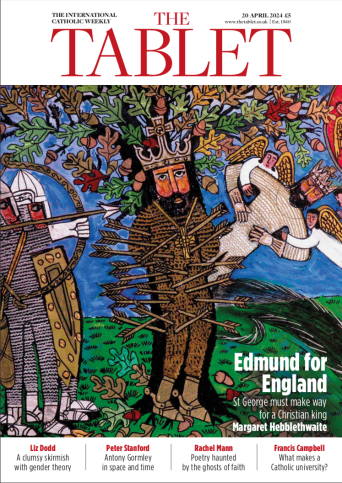How did she do it? Illegitimate, excommunicated, head of a disputed national Church, and, worst of all, a single woman – Elizabeth’s survival on the English throne for 45 years is one of the most remarkable political balancing acts of history.
If Garry Wills is right, it was more remarkable still. He maintains that the trick was done largely through smoke and mirrors. He traces the growth of a glorious, fabricated mystique in which queen and country, cut adrift from the ancient rituals of Catholic Europe, were both enthusiastically complicit. New iconography was needed: Elizabeth both provided and inspired it. Plays, sermons, poems, portraits, proclamations, processions, broadsheets, almanacs, even speeches on the scaffold, all contributed to the erection of the billowy, fragile structure.
England was in love with its indulgent Queen; the court thronged with her chivalric knights; Spain was the dragon of the Apocalypse, Rome the whore of Babylon; Elizabeth was Astraea, the Fairie Queene, Deborah, clasping to her breast the Bible, carried to her by Time from the cave of ignorance and error. Elizabeth’s hawk-like features and magnificent bearing are as familiar now as they were then: England lies at her feet, the Armada founders behind her, the sieve of purity is in her hand. The trick still works.
Wills is the Pulitzer Prize-winning author of almost 40 books on subjects ranging from Jefferson to contemporary Catholicism. He strides through the minefield of sixteenth-century studies, swatting aside dissenting scholars. A fine rhetorical writer, he revels in the anti-papal rhetoric of propagandists from Foxe to Spenser, and is particularly strong on the Dragon of the Apocalypse, which he detects in the jewelled snake on the left sleeve of the “Rainbow” portrait of the Queen, clearly a wriggling trophy of the defeated devil, Spain. He is “astonished” that eminent scholars like Frances Yates should have mistaken it for a symbol of Prudence, which first takes serpent form in a picture printed only after the portrait was painted. The Queen’s provocative display of the crushed Catholic dragon is something he refers to several times throughout the book. But Wills overlooks an important image widely disseminated some 30 years earlier. The frontispiece of the 1569 Bishops’ Bible portrays four virtues surrounding the Queen; to the lower right is Prudence with a snake curling up her left arm. In the Rainbow portrait the snake, also lower right, is crowned by a miniature astrolabe symbolising Intelligence, and surrounded by a plethora of eyes and ears, a tribute to the skills of the indispensable royal servants, the Cecils, in whose house it hangs.
Wills deals briskly with evidence that does not fit the triumphalist picture. He contests the famous comment made by an angry Elizabeth to her archivist, William Lambarde, that she was lampooned in the character of the despotic Richard II in Shakespeare’s play. “I am Richard II, know ye not that?” Wills claims that the boastful Lambarde simply made the whole conversation up. He would rather Elizabeth was not Richard, but Henry V. However, even the iconic Reformation hero Henry has his faults. Wills accordingly spends four chapters vigorously taking on spineless “Hal-haters” before advancing a tenuous link between his sanitised model king and Elizabeth. Yet, in a rare, overt political allusion, Shakespeare himself associated Henry with a character very different from Elizabeth – the militant, oppositional Earl of Essex.
Digressions like this, intended to draw Shakespeare into the myth-building camp, are the chief weakness of the book, undermining what would otherwise be an enjoyable overview of the burgeoning iconography of the English Protestant state.
As the myth soars away into the Stuart era, Wills continues to supply his own touches. He ends with a rightly admiring sketch of James I’s heir, Henry Frederick, a Protestant soldier with the artistic tastes of a Renaissance prince, who died tragically young in 1612. “No wonder”, says Wills, “James Sutton wrote that there was, over Europe, ‘Roman Catholic relief at his passing’.” But Sutton did not write this. He merely invited “further research” into the possible existence of such “relief”. In fact English Catholics had every reason to lament Henry’s death, as his Catholic marriage plans had just been concluded – a diplomatic coup long dreaded by Protestants. Not for the first time, Wills appears to be endorsing the Protestant myth, rather than describing it.
The final biographical sketches omit Elizabeth’s right-hand men, William and Robert Cecil. They were the real architects of the success of the Elizabethan Settlement. They were past masters at propaganda. In 1589 a pamphlet was printed in several languages, describing the gallant action of the Catholic Earl of Oxford against the Spanish Armada. In fact, in a spectacular act of disloyalty, Oxford had refused to take part. Only recently have handwritten drafts revealed that the author of the chivalric official version was the busily micromanaging Lord Treasurer himself, William Cecil.
A book remains to be written about the major role played by state servants like the Cecils in the construction of the Gloriana myth. What we have here is yet more evidence of its continuing power to dazzle.
02 October 2014, The Tablet
Making Make-Believe Real: politics as theater in Shakespeare’s time
All the political world’s a stage
Edmund for England
 Loading ...
Loading ...
Get Instant Access
Subscribe to The Tablet for just £7.99
Subscribe today to take advantage of our introductory offers and enjoy 30 days' access for just £7.99



What do you think?
You can post as a subscriber user...
User Comments (0)